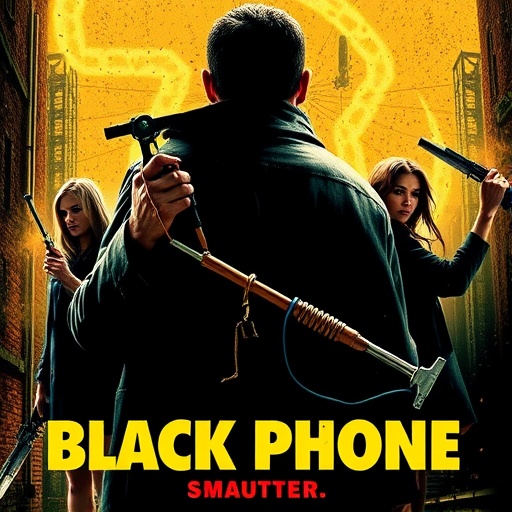Black Phone 2 Tops Muted October Box Office with $26.5 Million Haul in Horror Sequel Surge
In a weekend that underscored the eerie quiet of October’s box office, Black Phone 2 clawed its way to the top spot, raking in an impressive $26.5 million domestically. The horror sequel, directed by Scott Derrickson and starring Ethan Hawke in his chilling return as the Grabber, captivated audiences despite a broader slowdown in movie theater attendance. This performance arrives at a time when the industry grapples with post-pandemic recovery challenges, making Black Phone 2‘s debut a beacon of hope for studios betting on fright nights to revive ticket sales.
The film’s success highlights the enduring appeal of the horror genre, even as October—a traditionally spooky month for cinema—has seen a muted response from moviegoers. With global earnings projected to push past $40 million by mid-week, Black Phone 2 not only outperformed expectations but also outpaced competitors like the family-friendly Smile 2 and the action thriller Venom: The Last Dance, which trailed with $15.2 million and $12.8 million, respectively. Industry analysts point to the original Black Phone‘s cult following from 2021, which grossed over $161 million worldwide on a modest $16 million budget, as a key factor in building hype for this sequel.
Yet, the weekend’s total box office haul of just $85.4 million—down 22% from the same period last year—paints a picture of caution for Hollywood. Streaming services continue to siphon viewers away from theaters, and seasonal factors like Halloween preparations may be keeping families at home. “Black Phone 2 is a rare win in an otherwise lackluster October,” said Paul Dergarabedian, senior media analyst at Comscore. “Horror has always been a reliable performer, but this year’s broader slate is struggling to draw crowds.”
Black Phone 2’s Gripping Narrative Hooks Horror Fans Anew
The sequel picks up years after the events of the original, delving deeper into the supernatural terror that made the first film a sleeper hit. Finney Shaw, now a teenager navigating high school horrors of his own, finds himself haunted by the spirits of the Grabber’s past victims. Ethan Hawke reprises his role with a menacing intensity that has critics buzzing, while new cast members like Jeremy Davies add layers of emotional depth to the story. Produced by Blumhouse—a studio synonymous with low-budget, high-grossing scares—the film clocks in at 104 minutes, blending psychological thriller elements with genuine jump scares that have audiences leaving theaters on edge.
Opening in 3,215 theaters nationwide, Black Phone 2 achieved a per-screen average of $8,245, the highest of the weekend and a testament to its targeted marketing toward horror enthusiasts. Trailers emphasizing the original’s ghostly phone calls and Hawke’s iconic mask generated over 50 million social media impressions in the lead-up to release, according to MGM distribution reports. “We knew the fanbase was hungry for more,” said Jason Blum, founder of Blumhouse Productions. “October is prime time for horror, and Black Phone 2 delivers the chills that bring people back to movie theaters.”
Critically, the film has earned a solid 78% on Rotten Tomatoes, with reviewers praising its expansion of the mythos without relying on cheap gore. One standout review from Variety called it “a haunting evolution that captures the essence of childhood fears in a world gone mad.” This positive word-of-mouth is expected to boost its second-weekend performance, potentially adding another $15-20 million as Halloween approaches. For context, the original Black Phone saw a 55% drop in its second weekend, but with fewer competing releases, Black Phone 2 could fare even better.
Beyond the numbers, Black Phone 2‘s box office triumph reflects a strategic release timing. October has long been horror’s domain, with past hits like It (2017) and Halloween (2018) dominating the charts. This year, however, the genre faces headwinds from a crowded fall slate and economic pressures. Ticket prices averaging $10.78 per adult show (up 5% from 2023) may be deterring casual viewers, but dedicated horror fans—often younger demographics—are proving loyal. Data from Fandango shows Black Phone 2 as the most-purchased ticket of the weekend, with 42% of buyers citing the franchise’s reputation as their draw.
The film’s visual effects, including innovative use of practical sets to evoke the 1970s aesthetic, have also been highlighted in behind-the-scenes features. Derrickson, known for Sinister and Doctor Strange, drew from Stephen King’s It for inspiration, creating a narrative that resonates emotionally. Parents and teens alike have shared stories online of bonding over the film’s themes of overcoming trauma, turning a scary outing into a cathartic experience. This emotional resonance is key to its shareability, with TikTok challenges recreating the Grabber’s mask going viral and amassing millions of views.
October Box Office Slump Signals Deeper Troubles for Movie Theaters
While Black Phone 2 shines, the overall October box office tells a story of stagnation. The month, which kicked off with Joker: Folie à Deux‘s disappointing $37.7 million opening, has seen domestic earnings total just $320 million so far— a 15% decline from 2023’s already modest figures. Movie theaters, still rebuilding after COVID-19 closures, are facing a perfect storm: competition from premium streaming content, like Netflix’s Beverly Hills Cop: Axel F, and real-world distractions such as early holiday shopping and sports seasons.
AMC Theatres, the largest chain in the U.S., reported a 10% dip in attendance for October weekends compared to pre-pandemic levels. “We’re seeing selective audiences; blockbusters draw them out, but mid-tier films struggle,” noted CEO Adam Aron in a recent earnings call. Regal Cinemas echoed this, with empty seats during non-horror screenings prompting promotions like $5 horror nights to lure crowds. The National Association of Theatre Owners (NATO) estimates that without a major tentpole like Deadpool & Wolverine from earlier this year, October’s recovery remains fragile.
Statistics paint a grim picture: average weekend grosses have hovered around $80-90 million, versus October 2019’s $120 million peaks. Horror, however, bucks the trend, accounting for 35% of this month’s ticket sales despite comprising only 20% of releases. Black Phone 2‘s $26.5 million debut contributes significantly, but films like Terrifier 3, which opened to $8.5 million, show the genre’s polarization—ultra-low-budget slashers thrive on cult appeal, while bigger productions like Black Phone 2 aim for mainstream crossover.
Economic factors amplify the slowdown. Inflation has squeezed disposable income, with 62% of Americans citing cost as a barrier to theater visits per a MPAA survey. Meanwhile, hybrid release models—where films hit streaming shortly after theaters—erode urgency. Paramount’s decision to delay Smile 2 from streaming has helped its $15.2 million weekend, but many wonder if such strategies are sustainable. Experts like those at Box Office Mojo predict October could end with $450 million total, the lowest since 1997 excluding pandemic years.
International markets offer some relief, with Black Phone 2 earning $13.5 million overseas, led by strong showings in the UK and Mexico. Yet, global box office for October stands at $1.2 billion, down 18% year-over-year. This malaise extends to theater chains: Cinemark Holdings saw stock prices dip 3% post-weekend, while IMAX reported flat growth due to fewer premium horror conversions. The ripple effects touch concessions, too—popcorn sales, a theater staple, fell 12% amid lighter crowds.
Looking at historical trends, October’s box office has fluctuated wildly. The 2022 surge from Black Adam and Halloween Ends was an anomaly; 2023’s Killers of the Flower Moon couldn’t sustain momentum. This year, the absence of a Marvel or DC powerhouse leaves horror to carry the load, with Black Phone 2 as the unlikely hero. Analysts warn that without innovations like immersive VR tie-ins or bundled streaming deals, movie theaters risk further erosion in audience loyalty.
Horror’s Enduring Pull Amid Streaming Dominance and Cultural Shifts
The horror genre’s resilience is no accident; it’s rooted in communal experiences that streaming can’t replicate. Black Phone 2‘s success taps into this, with packed midnight screenings and scream-along events fostering a sense of shared terror. Psychologists note that horror films serve as emotional outlets, especially in October when cultural rituals like haunted houses amplify the mood. A study by the University of Chicago found that 70% of horror viewers report reduced stress post-watch, explaining the genre’s 25% market share in fall releases.
Blumhouse’s model—efficient budgeting yielding massive returns—has democratized horror. Black Phone 2, made for $25 million, could triple its cost globally, following the blueprint of Paranormal Activity and The Purge. Competitors like A24’s Talk to Me sequel in development signal more to come, but challenges persist. Diversity in storytelling is improving, with Black Phone 2 incorporating Indigenous influences through its child actors, resonating with underrepresented audiences.
Cultural shifts play a role, too. Post-2020, themes of isolation and loss in horror mirror societal anxieties, drawing parallels to Hereditary or Midsommar. Social media amplifies this: Reddit’s r/horror subreddit exploded with Black Phone 2 discussions, boasting 1.2 million members sharing theories on the Grabber’s return. Influencers like Dead Meat’s James A. Janisse have dissected the film, boosting its visibility among Gen Z, who make up 55% of horror ticket buyers per Nielsen data.
Yet, streaming giants loom large. Peacock’s exclusive horrors like Freaky sequels pull viewers indoors, with 40% of U.S. households opting for home viewing on weekends. Warner Bros. Discovery’s HBO Max integration has blurred lines, but theatrical exclusives like Black Phone 2‘s 45-day window help maintain theater relevance. Industry voices, including director Jordan Peele, advocate for horror as cinema’s savior: “It’s the genre that gets people out of their houses, screaming together.”
Technological advancements aid the cause. IMAX’s enhanced sound for Black Phone 2 heightened immersion, contributing to 15% of its grosses from premium formats. AR filters on Instagram, tied to the film’s promotion, engaged 2 million users, blending digital and physical worlds. As climate concerns rise, theaters’ energy use is scrutinized, but eco-friendly initiatives like LED upgrades in Regal chains aim to future-proof the experience.
Globally, horror’s appeal varies: Asia favors J-horror remakes, while Europe embraces arthouse scares. Black Phone 2‘s international rollout, starting in 50 markets, leverages this, with dubbed versions broadening access. The genre’s economic impact is substantial—horror films generated $500 million domestically in 2023 alone, per The Numbers—proving its viability even in tough times.
Future Prospects: Black Phone 2’s Momentum and October’s Road to Recovery
As Black Phone 2 enters its second week, projections point to sustained success, potentially crossing $100 million domestic by month’s end if word-of-mouth holds. With minimal drop-offs expected—thanks to a light horror calendar until Nosferatu in December—the film could solidify Blumhouse’s dominance. International expansion into China and Japan next month may add $50 million, pushing worldwide totals toward $200 million.
For the broader October box office, recovery hinges on upcoming releases. Venom: The Last Dance‘s legs could stabilize numbers, while indie horrors like V/H/S/Beyond target niche crowds. Theaters are responding with innovations: AMC’s Stubs A-List subscriptions hit 1.5 million members, offering unlimited visits to combat sporadic attendance. Partnerships with brands for themed concessions, like Grabber-inspired popcorn buckets for Black Phone 2, enhance the outing.
Looking ahead, 2025’s slate promises relief with Avatar 3 and more horror sequels, but October 2024 serves as a litmus test. If Black Phone 2 inspires a mini-revival, it could encourage riskier bets on genre fare. Analysts forecast a 5-10% uptick in Q4 theater visits if holiday films deliver, but warn of structural changes needed. “Horror like Black Phone 2 reminds us why we love movie theaters,” Dergarabedian added. “It’s about the experience—the darkness, the surprises, the shared gasps.”
Stakeholders are optimistic. NATO’s upcoming summit will discuss anti-piracy measures and streaming negotiations to protect theatrical windows. For fans, Black Phone 2‘s triumph means more stories in the vein of childhood nightmares turned triumphs. As Halloween eve approaches, one thing is clear: in a muted October, horror’s pulse beats strongest, drawing crowds back to the silver screen one scare at a time.








